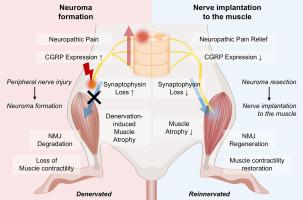Nerve implantation to the muscle after neuroma formation enables pain relief and motor function recovery with reinnervation in rats
IF 5.1
2区 医学
Q1 MEDICINE, RESEARCH & EXPERIMENTAL
引用次数: 0
Abstract
Aims
Neuroma formation after peripheral nerve injury inhibits functional recovery and contributes to neuropathic pain. This study aimed to evaluate whether nerve implantation into denervated muscle, even after neuroma formation, could promote motor and sensory functional restoration.
Materials and methods
A rat tibial nerve injury model was used. The tibial nerve was ligated and transected to induce neuroma, followed by nerve implantation into the gastrocnemius muscle at 12 days post-injury. Mechanical hypersensitivity was assessed by von Frey testing, and motor function was evaluated using the tibial nerve functional index (TFI). Histological analysis of neuromuscular junctions (NMJ), immunofluorescence of synaptophysin (SYP) in the spinal cord, and electromyography (EMG) were performed to assess reinnervation and synaptic recovery.
Key findings
Nerve implantation significantly reduced mechanical hypersensitivity beginning at 1-week post-implantation and maintained analgesic effects up to 30 weeks. Muscle atrophy was attenuated, and CSA was preserved in the implanted group. NMJ morphology was partially restored, and EMG confirmed partial recovery of neurophysiological muscle contraction beginning at 8 weeks and more clearly at 12 weeks. SYP expression in the ventral horn was significantly preserved at 30 weeks, indicating central modulation of motor signaling. Improvement in TFI supported motor restoration.
Significance
This study demonstrates that delayed nerve implantation into denervated muscle after neuroma formation can achieve motor and sensory recovery through reinnervation. These findings provide insights into the potential effects on nerve-muscle reconstruction treatment for peripheral nerve injury and establish an experimental basis for future clinical application with mechanism studies.

神经瘤形成后将神经植入肌肉,使大鼠神经再生后疼痛缓解和运动功能恢复。
目的:周围神经损伤后神经瘤的形成抑制了神经功能的恢复,并导致神经性疼痛。本研究旨在评估神经植入失神经支配肌肉,即使在神经瘤形成后,是否可以促进运动和感觉功能的恢复。材料与方法:采用大鼠胫骨神经损伤模型。将胫骨神经结扎并横断以诱导神经瘤,然后在损伤后12 天将神经植入腓肠肌。采用von Frey试验评估机械超敏反应,采用胫神经功能指数(TFI)评估运动功能。通过神经肌肉连接(NMJ)的组织学分析、脊髓突触素(SYP)的免疫荧光和肌电图(EMG)来评估神经再生和突触恢复情况。主要发现:神经植入术显著降低了植入术后1周开始的机械超敏反应,并保持了长达30 周的镇痛效果。植入组肌肉萎缩减轻,CSA保存完好。NMJ形态部分恢复,肌电图证实神经生理肌肉收缩在8 周开始部分恢复,在12 周更加明显。SYP在腹角的表达在30 周显著保留,表明运动信号的中枢调节。TFI支持的运动恢复的改善。意义:本研究表明神经瘤形成后延迟神经植入失神经支配肌,可通过神经再支配实现运动和感觉恢复。这些发现为神经肌肉重建治疗周围神经损伤的潜在作用提供了新的思路,并为今后的临床应用机制研究奠定了实验基础。
本文章由计算机程序翻译,如有差异,请以英文原文为准。
求助全文
约1分钟内获得全文
求助全文
来源期刊

Life sciences
医学-药学
CiteScore
12.20
自引率
1.60%
发文量
841
审稿时长
6 months
期刊介绍:
Life Sciences is an international journal publishing articles that emphasize the molecular, cellular, and functional basis of therapy. The journal emphasizes the understanding of mechanism that is relevant to all aspects of human disease and translation to patients. All articles are rigorously reviewed.
The Journal favors publication of full-length papers where modern scientific technologies are used to explain molecular, cellular and physiological mechanisms. Articles that merely report observations are rarely accepted. Recommendations from the Declaration of Helsinki or NIH guidelines for care and use of laboratory animals must be adhered to. Articles should be written at a level accessible to readers who are non-specialists in the topic of the article themselves, but who are interested in the research. The Journal welcomes reviews on topics of wide interest to investigators in the life sciences. We particularly encourage submission of brief, focused reviews containing high-quality artwork and require the use of mechanistic summary diagrams.
 求助内容:
求助内容: 应助结果提醒方式:
应助结果提醒方式:


